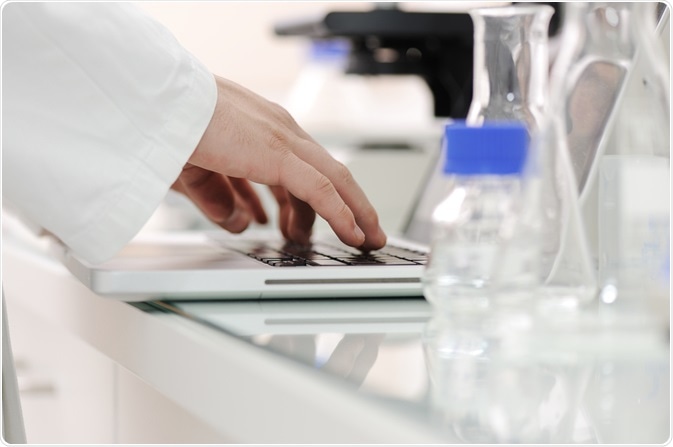Though the paper lab notebook is still the most widely used form of tracking data, researchers are amassing more and more interest in electronic lab notebooks (ELN’s). Over one hundred ELN platforms are currently in use within the current market.

Image Credit: ESB Professional/Shutterstock.com
To list just a few benefits when it comes to electronic lab notebooks; they can be accessed anywhere, troubleshooting across colleagues and students is enriched (given the ease in which data can be accessed), and information can be attained and cataloged in a more systematized manner. Biotech companies are coming around to this innovation, though choosing the right ELN requires forethought, and the dynamics of each laboratory team must be considered.
The Benefits of ELN’s
As per the nature of their functionality, these ELN’s are used to record the hypotheses of researchers, as well as their experimental procedures and initial analyses. These software’s are formatted to serve as an organizational tool, an aid to memory, and to shelter the intellectual property of any platform user.
Teachers claim that information resources are more easily updated and that they can quickly revise lab manuals, safety information, and protocols ubiquitously. ELN’s share many parallels to a paper lab notebook, though the functionality that is layered on top of these software’s show great promise.
Many lab managers also attest to the success of ELN’s, granting them the ability to swiftly delegate tasks to appropriate subordinates within a certain organization. It will also allow for systematized and rapid communication between different lab divisions, like relaying a data spreadsheet from an analytical lab to a synthesis lab.
Almost all ELN’s have the auxiliary benefit of searching power, much like the “command F” function on many laptops, granting the ability to search through results at any given time at a fraction of the speed it would normally take to flip through one or more notebooks. Open lab ELN’s also facilitate the importing and exporting of files, with many having garnered the drag and drop function found on any computer.
A select few are compatible with Microsoft software, such as excel spreadsheets, synchronized OneNote pages, word/docx documents, and more. This makes open lab compatible with any type of file, or data in your laboratory. Open Lab ELN’s also allow you to create templates, standardizing workflow. It is also much easier to avoid transcription errors, circumventing issues of penmanship and legibility. Because these ELN’s are extremely user-friendly, this makes them flexible enough to be used by biologists, chemists, and physicists alike, befitting a vast assortment of disciplines.
The globalization we see in our world today is expanding, it is only natural that our scientific methodologies expand with it. These open lab ELN’s allow for different teams to collaborate across the globe. They permit different standard operating procedures to be shared in different labs, and even in the comfort of one’s home.
Questions to Consider Before Assigning ELN’s
Though all these benefits do come into play, it is important to note that some laboratories may find it more difficult to acclimate to this new technology. The question of importing all analog and paper backfiles into digital files remains to be seen; it will not be an effortless process.
In addition, the question of how easily lab employees will adapt to the new electronic format remains. It may create a more compliant lab for some, but those that have a disliking towards technology may not have that same sentiment.
Selecting a Given ELN
It is generally regarded that the time and energy it takes to familiarize yourself with ELN’s is well worth it. The question then becomes, which ELN would be best suited for your laboratory team? This choice could prove difficult, having to take into account the price, user interface, and tools that are best suited for the individual or group.
For example, the SciNote program allows for Microsoft office integration, one could generate reports and manuscripts with relative ease, and the option of a free account is available. However, gene editing tools like primer design and CRISPR/CAS9 genome editing are not available in this given platform. For these reasons, it could be argued that this ELN would be more suited for physicists inorganic chemists, and less so for geneticists and biochemists.
In contrast, software such as Benchling and Signalsnotebook have very powerful tools to edit APB genome sequences, generate guide primers for CRISPR, and create virtual digests when planning out site-directed mutagenesis. They also support chemical structures, and Signalsnotebook can even work in conjunction with Chemdraw, a very popular tool amidst chemists These programs generally have a good amount of storage (roughly 10 GB) and can be used as an application, or via their online version.
On the offhand, the free plan these programs offer may have limited functions and are not as practical when composing long written proposals and transcribing entire lab reports. For these reasons, these ELN’s are commonly used within genomics and molecular biology.
Sources:
- STU BORMAN Electronic Laboratory Notebooks May Revolutionize Research Record Keeping Chemical & Engineering News Archive 1994 72 (21), 10-20
- Erika Szymanski and Emily Scher Models for DNA Design Tools: The Trouble with Metaphors Is That They Don’t Go Away ACS Synthetic Biology 2019 8 (12), 2635-2641
- Sarah R. Soltau, Student and Instructor Perceptions of Using Electronic Laboratory Notebooks in Microsoft OneDrive to Enhance Communication Skills and Career Readiness in Chemistry Laboratory Courses, ACS Symposium 2020 15 259-279
- Megan Grabenauer, Wojciech L. Krol, Jenny L. Wiley, and Brian F. Thomas. Analysis of Synthetic Cannabinoids Using High-Resolution Mass Spectrometry and Mass Defect Filtering: Implications for Nontargeted Screening of Designer Drugs. Analytical Chemistry 2012 84 (13), 5574-5581
Further Reading